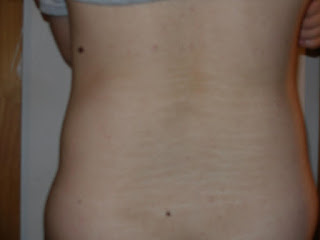Having stretch marks is considered a nightmare by many women. The obsession with physical beauty has made women want to look perfect in every part of their body. Certainly, having breast stretch marks can ruin that unforgiving concept of beauty. The good news is that stretch marks can be somehow avoided and, if you have the money, can be cured.
Dermatology has defined stretch marks, also called as striae, as a form of scarring on the skin caused by the tearing of the dermis, which is the middle layer helping the skin retain its original shape. Stretch marks develop when there is rapid stretching of the skin, which happens during immediate growth in early puberty or in the last stages of pregnancy. When the rapid stretching of the skin overpowers the elasticity of the dermis, causing streaks in a silvery white due to appear on the affected areas, which may be the thighs, buttocks, hips, belly, arms, and/or breasts. This means that, as long as the dermis is supported, no breast stretch marks will occur.
Thus, perhaps the best way to fight breast stretch marks is to avoid getting them. You must ensure the dermis in your chest area remains supported especially when you are experiencing weight gain due to pregnancy or some other cause. To help you do this, use an effective moisturizer, lotion or oil and massage your breasts regularly to help improve blood circulation and the elasticity of your skin. Studies have shown that regular application of Trofolastin or Verum can prevent the development of several depressed skin streaks or stretch marks. Trofolastin is a cream that contains collagen-elastin hydrolysates, vitamin E, and extracts of Centella asiatica, while Verum is yet another creams that contains elastin, hyaluronic acid, menthol, panthenol, and vitamin E. Together, these ingredients provide the supportive material that prevents epidermal and dermal tearing.
There is an ingredient found in creams, ointments, lotions, and other topical medications that claim to lighten stretch marks which you should avoid if you are pregnant or breastfeeding: Retin-A. There have been studies that associated Retin-A with risks in pregnancies. Although there is no proof that Retin-A has adverse effects on mothers who breastfeed and their babies, doctors have advised against using stretch marks solutions containing this substance. Cocoa butter, on the other hand, is one ingredient that enjoys popularity and is highly recommended.
Stretch marks first appear in a color that's far from your skin color. They are usually born in purple, brown, or reddish color but will soon fade into gray. While stretch marks will totally disappear, breast stretch marks can be cured to lighten fast and blend with the color of your skin so that they will become less noticeable to the unknowing eye.
Some women resort to cosmetic surgery to remove their breast stretch marks. Laser treatments and dermabrasion are some of the technological cures for stretch marks, not only in the breast area but in other areas in the body that have stretch marks.



